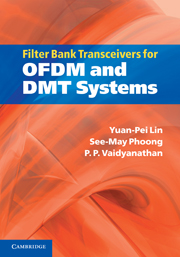Book contents
- Frontmatter
- Dedication
- Contents
- Preface
- 1 Introduction
- 2 Preliminaries of digital communications
- 3 FIR equalizers
- 4 Fundamentals of multirate signal processing
- 5 Multirate formulation of communication systems
- 6 DFT-based transceivers
- 7 Precoded OFDM systems
- 8 Transceiver design with channel information at the transmitter
- 9 DMT systems with improved frequency characteristics
- 10 Minimum redundancy FIR transceivers
- A Mathematical tools
- B Review of random processes
- References
- Index
10 - Minimum redundancy FIR transceivers
Published online by Cambridge University Press: 05 August 2015
- Frontmatter
- Dedication
- Contents
- Preface
- 1 Introduction
- 2 Preliminaries of digital communications
- 3 FIR equalizers
- 4 Fundamentals of multirate signal processing
- 5 Multirate formulation of communication systems
- 6 DFT-based transceivers
- 7 Precoded OFDM systems
- 8 Transceiver design with channel information at the transmitter
- 9 DMT systems with improved frequency characteristics
- 10 Minimum redundancy FIR transceivers
- A Mathematical tools
- B Review of random processes
- References
- Index
Summary
In earlier chapters we saw that the use of redundancy in block transceivers allows us to remove ISI completely without using IIR filters. When the number of redundant samples per block v is more than the channel order L, there is no IBI, and we can further achieve zero ISI using a constant receiving matrix. The most notable example is the OFDM system studied in Chapter 6. But the use of redundant samples also decreases the transmission rate. For every M input symbols, the transmitter sends out N = M + ν samples. The actual transmission rate is decreased by a factor of N/M. There are ν redundant samples in every N samples transmitted. Reducing redundancy leads to a higher transmission rate and hence better bandwidth efficiency. At the same time, we would like the redundancy to be large enough so that the zero-forcing condition can still be satisfied without using IIR filters. A natural question to ask is: for a given channel and N, what is the smallest redundancy such that FIR transceivers exist? In other words, if we are to use an FIR transceiver that achieves zero ISI, what is the largest number of symbols that can be transmitted out of every N samples? This chapter aims to answer the question of minimum redundancy for the existence of FIR zero-forcing transceivers.
We will consider general FIR transceivers (Fig. 10.1) in which the filters are not constrained to be DFT filters as in the OFDM system. Moreover the length of the filters can be longer than the block size N. In this case the transmitting and receiving matrices are allowed to have memories, rather than constant matrices as in the OFDM case. We will see that the minimum redundancy depends on the underlying channel C(z), and it can be easily determined from the location of the zeros of the channel C(z) directly by inspection. The topic of minimum redundancy for FIR transceivers was first addressed in [182].
- Type
- Chapter
- Information
- Filter Bank Transceivers for OFDM and DMT Systems , pp. 291 - 322Publisher: Cambridge University PressPrint publication year: 2010



